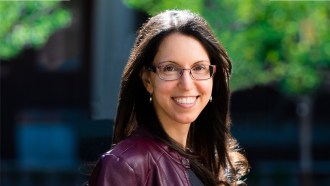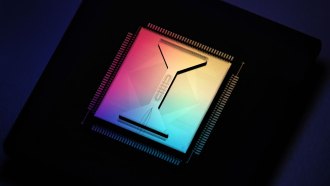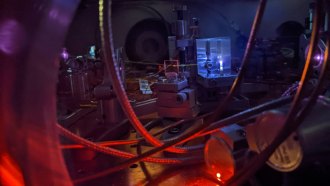
Physics writer Emily Conover joined Science News in 2016. She has a Ph.D. in physics from the University of Chicago, where she studied the weird ways of neutrinos, tiny elementary particles that can zip straight through the Earth. She got her first taste of science writing as a AAAS Mass Media Fellow for the Milwaukee Journal Sentinel. She has previously written for Science Magazine and the American Physical Society. She is a two-time winner of the D.C. Science Writers’ Association Newsbrief award.

Trustworthy journalism comes at a price.
Scientists and journalists share a core belief in questioning, observing and verifying to reach the truth. Science News reports on crucial research and discovery across science disciplines. We need your financial support to make it happen – every contribution makes a difference.
All Stories by Emily Conover
-
 Particle Physics
Particle PhysicsPhysicists just discovered the rarest particle decay ever
The “golden channel” decay of subatomic particles called kaons could break or confirm the standard model of particle physics.
-
 Quantum Physics
Quantum PhysicsWhy this physicist is bringing thermodynamics to the quantum age
Like a steampunk fantasy-world, which pairs high-tech with an old-timey setting, Nicole Yunger Halpern melds old and new science.
-
 Particle Physics
Particle PhysicsA neutrino mass mismatch could shake cosmology’s foundations
Cosmological data suggest unexpected masses for neutrinos, including the possibility of zero or negative mass.
-
 Particle Physics
Particle PhysicsThe Large Hadron Collider exposes quarks’ quantum entanglement
Top quarks and antiquarks produced in the Large Hadron Collider are entangled, a study shows.
-
 Physics
PhysicsHow to spot tiny black holes that might pass through the solar system
Flybys of primordial black holes may occur once a decade. Tweaks to the orbits of planets and GPS satellites could give away their presence.
-
 Quantum Physics
Quantum PhysicsA quantum computer corrected its own errors, improving its calculations
The corrected calculation had an error rate about a tenth of one done without quantum error correction.
-
 Cosmology
CosmologyIn an epic cosmology clash, rival scientists begin to find common ground
Different measurements of the cosmic expansion rate disagree. The James Webb telescope could determine whether that disagreement is real.
-
 Physics
PhysicsA nuclear clock prototype hints at ultraprecise timekeeping
Nuclear clocks could rival atomic clocks and allow for new tests of fundamental physics. A new experiment demonstrates all the ingredients needed.
-
 Physics
PhysicsMayo is weirdly great for understanding nuclear fusion experiments
Mayonnaise’s texture is perfect for mimicking what a fusion fuel capsule goes through after it’s blasted with lasers.
-
 Particle Physics
Particle PhysicsThe possibilities for dark matter have just shrunk — by a lot
The LZ dark matter experiment has ruled out weakly interacting massive particles, or WIMPs, with a wide range of properties.
-
 Health & Medicine
Health & Medicine50 years ago, scientists blamed migraines on cheese and chocolate
Exactly how migraines develop is still coming into focus, but scientists now know that many factors can trigger attacks.
-
 Physics
PhysicsPaper cut physics pinpoints the most hazardous types of paper
Dot matrix printer paper is the most treacherous, physicists report. Magazine paper comes in second.